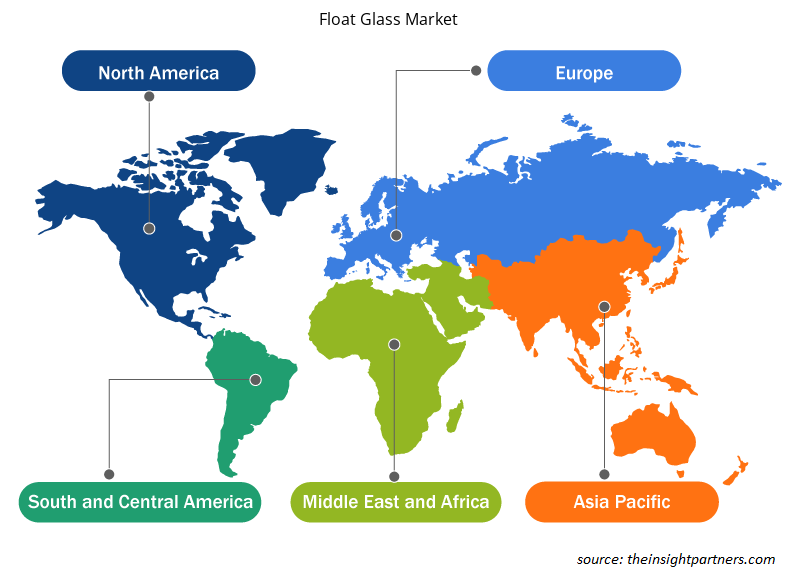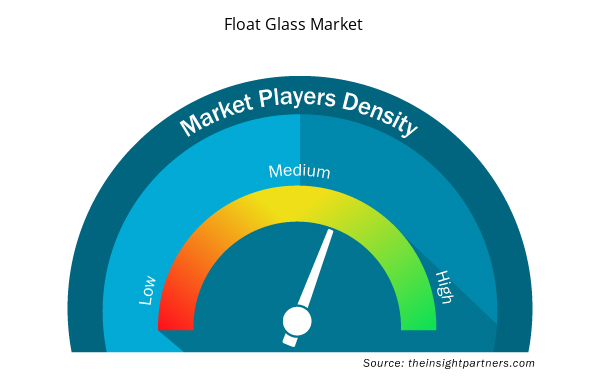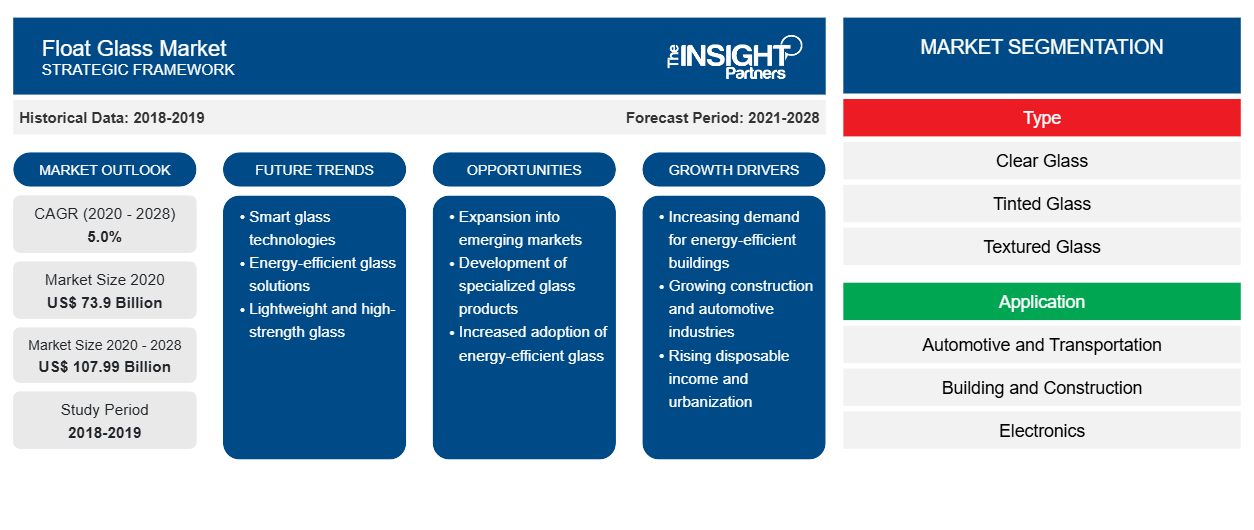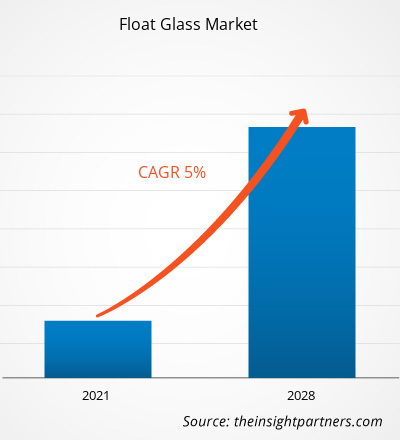2020 年浮法玻璃市场价值为 738.9783 亿美元,预计到 2028 年将达到 1079.9135 亿美元;预计 2021 年至 2028 年的复合年增长率为 5.0%。
浮法玻璃是一种极其光滑且无变形的玻璃,用于各种终端行业,如建筑、汽车、电子、太阳能等。它基本上是通过将熔融玻璃从熔炉倒入含有熔融锡床的腔室中制成的。浮法玻璃在室内设计和现代建筑中的使用增加在增加浮法玻璃的需求方面发挥了重要作用,并用于其他建筑和施工应用,包括天花板、地板、反光、涂层、窗户、镜子、桌面和绝缘玻璃。此外,浮法在汽车应用中的使用日益增加预计将在预测期内推动浮法玻璃行业的发展。
2020 年,亚太地区占据全球浮法玻璃市场的最大份额。汽车行业和建筑行业的不断发展推动了该地区对浮法玻璃的需求。中国和印度等国家庞大的成熟汽车行业也增加了这些国家对浮法玻璃的需求。与此同时,亚太地区太阳能行业的发展和渗透率的提高也推动了该地区浮法玻璃市场的增长。
定制此报告以满足您的需求
您可以免费定制任何报告,包括本报告的部分内容、国家级分析、Excel 数据包,以及为初创企业和大学提供优惠和折扣
- 获取此报告的关键市场趋势。这个免费样品将包括数据分析,从市场趋势到估计和预测。
由于 COVID-19 疫情,北美、欧洲、亚太地区、南美、中东和非洲的多家制造工厂关闭,阻碍了全球供应链和制造流程、交付计划和产品销售。此外,欧洲、亚洲和北美各国实施的限制措施正在影响业务协作和伙伴关系机会。持续的 COVID-19 疫情对浮法玻璃市场产生了重大影响。生产和供应链中断对浮法玻璃市场产生了负面影响。预计玻璃短缺将持续到 2021 年,导致各种业务中断。由于全球疫情和国际关税等各种问题,玻璃供应正在收紧,购买成本也更高。由于全球疫情,许多工厂和制造商不得不暂停或减缓玻璃生产,这使得满足当前需求变得极其困难。工厂在长期关闭或低产量生产后重启可能极具挑战性,尤其是当企业因健康和安全法规而无法满负荷运转时。此外,由于 COVID-19 疫苗接种是公众和卫生企业的首要任务,玻璃供应被转移到导致其他行业无法获得玻璃的事业上,从而造成市场玻璃短缺。
市场洞察
建筑业需求增加
浮法玻璃是通过熔炼工艺制造的,将回收的玻璃、石灰、硅砂、钾和苏打在熔炉中熔化,然后漂浮在熔融的锡床上。浮法玻璃在建筑行业中的应用越来越广泛,包括住宅、商业和工业部门。浮法玻璃具有高透光率、产生各种颜色和不透明度的能力以及良好的化学惰性,这增加了建筑行业对浮法玻璃的需求。浮法玻璃用于住宅部门的门窗,既美观又实用。它也越来越多地用于室内设计和现代建筑。在商业领域,浮法玻璃需求旺盛,因为它提供了美观且易于维护的外表面。浮法玻璃具有透光和透热性,可根据不同的季节和气候影响建筑物内部所需的加热和冷却量。由于浮法玻璃具有透明性、硬度和易于清洁的特点,因此也被用作零售店的展示窗。由于人们对环境问题的关注度不断上升,建筑行业对浮法玻璃的需求不断增加,因为它有助于住宅和商业建筑获得能源与环境设计先锋奖 (LEED) 认证。消费者对建筑安全意识的提高以及对维护政府建筑规范的日益重视预计将进一步增加对浮法玻璃的需求。因此,建筑行业对浮法玻璃的需求不断增加将推动预测期内浮法玻璃市场的增长。
类型洞察
根据类型,浮法玻璃市场细分为透明玻璃、有色玻璃、纹理玻璃等。2020 年,透明玻璃占据了最大的市场份额。透明玻璃是一种浮法玻璃,透明且无缺陷和光学畸变。与其他类型的浮法玻璃相比,透明浮法玻璃具有独特的特性,例如表面光洁度提高、厚度均匀、光学质量高、平整度高和外观明亮,因此质量更佳。它适用于需要高可见度和清晰度的区域,例如窗户、门、镜子、温室、天窗、家电和日光浴室。由于透明玻璃没有任何光学畸变或小缺陷,因此可以提供完美的视野。该玻璃还用于进一步加工以生产其他类型的玻璃。
浮法玻璃市场的一些主要市场参与者包括 AGC Inc.、日本板硝子株式会社 (NSG 集团)、信义玻璃控股有限公司、肖特股份公司、加迪安工业控股公司、Cardinal Glass Industries, Inc.、中国玻璃控股有限公司、深圳太阳环球玻璃有限公司、圣戈班玻璃印度公司和青岛米戈玻璃有限公司。市场的主要参与者正在采用并购和产品发布等策略来扩大地理覆盖范围和消费者基础。
浮法玻璃市场区域洞察
Insight Partners 的分析师已详细解释了预测期内影响浮法玻璃市场的区域趋势和因素。本节还讨论了北美、欧洲、亚太地区、中东和非洲以及南美和中美洲的浮法玻璃市场细分和地理位置。

- 获取浮法玻璃市场的区域具体数据
浮法玻璃市场报告范围
| 报告属性 | 细节 |
|---|---|
| 2020 年市场规模 | 739亿美元 |
| 2028 年市场规模 | 1079.9亿美元 |
| 全球复合年增长率(2020 - 2028) | 5.0% |
| 史料 | 2018-2019 |
| 预测期 | 2021-2028 |
| 涵盖的领域 | 按类型
|
| 覆盖地区和国家 | 北美
|
| 市场领导者和主要公司简介 |
|
市场参与者密度:了解其对商业动态的影响
浮法玻璃市场正在快速增长,这得益于终端用户需求的不断增长,而这些需求又源于消费者偏好的不断变化、技术进步以及对产品优势的认识不断提高等因素。随着需求的增加,企业正在扩大其产品范围,进行创新以满足消费者的需求,并利用新兴趋势,从而进一步推动市场增长。
市场参与者密度是指在特定市场或行业内运营的企业或公司的分布情况。它表明在给定市场空间中,相对于其规模或总市场价值,有多少竞争对手(市场参与者)存在。
在浮法玻璃市场运营的主要公司有:
- AGC公司
- 卡迪纳尔玻璃工业公司
- 日本板硝子株式会社
- 中国玻璃控股有限公司
- 加迪安工业控股公司
免责声明:上面列出的公司没有按照任何特定顺序排列。

- 获取浮法玻璃市场顶级关键参与者概述
报告亮点
- 浮法玻璃行业的进步趋势有助于参与者制定有效的长期战略
- 公司采用的业务增长战略来确保发达市场和发展中市场的增长
- 2019 年至 2028 年全球浮法玻璃市场定量分析
- 各行业对浮法玻璃的需求估计
- 波特分析说明了行业内买家和供应商预测市场增长的有效性
- 了解竞争激烈的市场形势和浮法玻璃的需求的最新发展
- 市场趋势和前景,以及推动和抑制浮法玻璃市场增长的因素
- 了解支撑全球浮法玻璃市场增长的商业利益的战略,有助于决策过程
- 浮法玻璃市场各节点规模
- 全球浮法玻璃市场的详细概述和细分以及其行业动态
- 浮法玻璃市场规模在各地区均有良好的增长机会
浮法玻璃市场(按类型)
- 透明玻璃
- 有色玻璃
- 纹理玻璃
- 其他的
浮法玻璃市场(按应用)
- 汽车和运输
- 建筑和施工
- 电子产品
- 其他的
公司简介
- AGC公司
- 日本板硝子株式会社(NSG集团)
- 信义玻璃控股有限公司
- 肖特公司
- 加迪安工业控股公司
- 卡迪纳尔玻璃工业公司
- 中国玻璃控股有限公司
- 深圳市太阳环球玻璃有限公司
- 圣戈班玻璃印度公司
- 青岛米果玻璃有限公司
- 历史分析(2 年)、基准年、预测(7 年)及复合年增长率
- PEST 和 SWOT 分析
- 市场规模价值/数量 - 全球、区域、国家
- 行业和竞争格局
- Excel 数据集


- Europe Industrial Chillers Market
- Electronic Toll Collection System Market
- Machine Condition Monitoring Market
- Microplate Reader Market
- Intraoperative Neuromonitoring Market
- Wind Turbine Composites Market
- Employment Screening Services Market
- Oxy-fuel Combustion Technology Market
- Skin Graft Market
- Personality Assessment Solution Market

Report Coverage
Revenue forecast, Company Analysis, Industry landscape, Growth factors, and Trends

Segment Covered
This text is related
to segments covered.

Regional Scope
North America, Europe, Asia Pacific, Middle East & Africa, South & Central America

Country Scope
This text is related
to country scope.
常见问题
During the forecast period, Asia Pacific is the dominating region for float glass market over the forecast period. The growing building and construction industry along with the increasing projects related to the field of renewable energy source and development of solar industry is driving the growth of float glass market in Asia Pacific region. Asia-pacific region especially China, Japan and India are expected to increase the demand for float glass as compare to other geographical regions which is due to an expanded and established automotive, building and construction sector in this region. Along with this, increasing manufacturing industries coupled with growing industrialization which offers ample opportunities for key market players in the float glass market. Presence of various domestic and international players in the region will increased the focus of manufacturers on providing innovative products leading to increased opportunity for the float glass market top grow
The major players operating in the global float glass market are AGC Inc., CARDINAL GLASS INDUSTRIES, INC., Nippon Sheet Glass Co., Ltd., China Glass Holdings Limited., Guardian Industries Holdings., SHENZHEN SUN GLOBAL GLASS CO., LTD., Saint-Gobain Glass India., SCHOTT AG., QINGDAO MIGO GLASS CO.,LTD., and Xinyi Glass Holdings Limited, amongst ohers.
Based on application, the building and construction segment is anticipated to account for the largest share in the global float glass market. Clear float glass, tinted float glass, and textured float glass are used in residential and commercial applications such as windows and doors for aesthetic and functional purposes. The increase in the use of the glass in interior design and architecture has played a major role in increasing the demand of float glass along with being used towards the ceiling, flooring, reflective, coated, windows, mirrors, tabletops, and insulated glass.
On the basis of type, the clear glass segment led the global float glass market in 2020. Clear float glass is a super smooth, distortion-free glass used for production and designing other glass items, including laminated glass and heat-toughened glass. It has unique features such as uniform thickness, high optical quality, excellent surface finishing, and bright appearance. Clear float glass is made up of molten glass, which flows through tweel to a tin bath and then to the lehr. The clear windows are suitable for glazing windows and doors in various sizes and thicknesses. It is used in windows and doors, mirrors, curtain walls, shelving and display cases, skylights, atriums, and handrails. The clear float glass provides optical clarity, high light transmission, and stable chemical properties.
On the basis of geography, Europe region is the fastest growing region in the global float glass market during the forecasted period. The growth can be attributed growing automotive and building and construction industry. Along with this, Europe is one of the largest producers of flat glass including float glass as well. The presence of large numbers of float glass manufacturing sites across the European region is helping the float glass market to grow.
Rise in Preference for Float Glass in Electronic Industry is one of the key drivers for the growth of the global float glass market. There has been a rising preference for float glass in the electronic industry worldwide due to its various benefits. Through a series of processing on float glass, including cutting, coating, drilling, grinding, and screen printing, the glass can be used for electronic or electric equipment such as LCD screen, touch screen, advertising machine screen, flat panel, and electromagnetic oven.
Trends and growth analysis reports related to Chemicals and Materials : READ MORE..
The List of Companies - Float Glass Market
- AGC Inc
- CARDINAL GLASS INDUSTRIES, INC
- Nippon Sheet Glass Co., Ltd
- China Glass Holdings Limited
- Guardian Industries Holdings
- SHENZHEN SUN GLOBAL GLASS CO., LTD
- Saint-Gobain Glass India
- SCHOTT AG
- QINGDAO MIGO GLASS CO.,LTD
- Xinyi Glass Holdings Limited
The Insight Partners performs research in 4 major stages: Data Collection & Secondary Research, Primary Research, Data Analysis and Data Triangulation & Final Review.
- Data Collection and Secondary Research:
As a market research and consulting firm operating from a decade, we have published and advised several client across the globe. First step for any study will start with an assessment of currently available data and insights from existing reports. Further, historical and current market information is collected from Investor Presentations, Annual Reports, SEC Filings, etc., and other information related to company’s performance and market positioning are gathered from Paid Databases (Factiva, Hoovers, and Reuters) and various other publications available in public domain.
Several associations trade associates, technical forums, institutes, societies and organization are accessed to gain technical as well as market related insights through their publications such as research papers, blogs and press releases related to the studies are referred to get cues about the market. Further, white papers, journals, magazines, and other news articles published in last 3 years are scrutinized and analyzed to understand the current market trends.
- Primary Research:
The primarily interview analysis comprise of data obtained from industry participants interview and answers to survey questions gathered by in-house primary team.
For primary research, interviews are conducted with industry experts/CEOs/Marketing Managers/VPs/Subject Matter Experts from both demand and supply side to get a 360-degree view of the market. The primary team conducts several interviews based on the complexity of the markets to understand the various market trends and dynamics which makes research more credible and precise.
A typical research interview fulfils the following functions:
- Provides first-hand information on the market size, market trends, growth trends, competitive landscape, and outlook
- Validates and strengthens in-house secondary research findings
- Develops the analysis team’s expertise and market understanding
Primary research involves email interactions and telephone interviews for each market, category, segment, and sub-segment across geographies. The participants who typically take part in such a process include, but are not limited to:
- Industry participants: VPs, business development managers, market intelligence managers and national sales managers
- Outside experts: Valuation experts, research analysts and key opinion leaders specializing in the electronics and semiconductor industry.
Below is the breakup of our primary respondents by company, designation, and region:

Once we receive the confirmation from primary research sources or primary respondents, we finalize the base year market estimation and forecast the data as per the macroeconomic and microeconomic factors assessed during data collection.
- Data Analysis:
Once data is validated through both secondary as well as primary respondents, we finalize the market estimations by hypothesis formulation and factor analysis at regional and country level.
- Macro-Economic Factor Analysis:
We analyse macroeconomic indicators such the gross domestic product (GDP), increase in the demand for goods and services across industries, technological advancement, regional economic growth, governmental policies, the influence of COVID-19, PEST analysis, and other aspects. This analysis aids in setting benchmarks for various nations/regions and approximating market splits. Additionally, the general trend of the aforementioned components aid in determining the market's development possibilities.
- Country Level Data:
Various factors that are especially aligned to the country are taken into account to determine the market size for a certain area and country, including the presence of vendors, such as headquarters and offices, the country's GDP, demand patterns, and industry growth. To comprehend the market dynamics for the nation, a number of growth variables, inhibitors, application areas, and current market trends are researched. The aforementioned elements aid in determining the country's overall market's growth potential.
- Company Profile:
The “Table of Contents” is formulated by listing and analyzing more than 25 - 30 companies operating in the market ecosystem across geographies. However, we profile only 10 companies as a standard practice in our syndicate reports. These 10 companies comprise leading, emerging, and regional players. Nonetheless, our analysis is not restricted to the 10 listed companies, we also analyze other companies present in the market to develop a holistic view and understand the prevailing trends. The “Company Profiles” section in the report covers key facts, business description, products & services, financial information, SWOT analysis, and key developments. The financial information presented is extracted from the annual reports and official documents of the publicly listed companies. Upon collecting the information for the sections of respective companies, we verify them via various primary sources and then compile the data in respective company profiles. The company level information helps us in deriving the base number as well as in forecasting the market size.
- Developing Base Number:
Aggregation of sales statistics (2020-2022) and macro-economic factor, and other secondary and primary research insights are utilized to arrive at base number and related market shares for 2022. The data gaps are identified in this step and relevant market data is analyzed, collected from paid primary interviews or databases. On finalizing the base year market size, forecasts are developed on the basis of macro-economic, industry and market growth factors and company level analysis.
- Data Triangulation and Final Review:
The market findings and base year market size calculations are validated from supply as well as demand side. Demand side validations are based on macro-economic factor analysis and benchmarks for respective regions and countries. In case of supply side validations, revenues of major companies are estimated (in case not available) based on industry benchmark, approximate number of employees, product portfolio, and primary interviews revenues are gathered. Further revenue from target product/service segment is assessed to avoid overshooting of market statistics. In case of heavy deviations between supply and demand side values, all thes steps are repeated to achieve synchronization.
We follow an iterative model, wherein we share our research findings with Subject Matter Experts (SME’s) and Key Opinion Leaders (KOLs) until consensus view of the market is not formulated – this model negates any drastic deviation in the opinions of experts. Only validated and universally acceptable research findings are quoted in our reports.
We have important check points that we use to validate our research findings – which we call – data triangulation, where we validate the information, we generate from secondary sources with primary interviews and then we re-validate with our internal data bases and Subject matter experts. This comprehensive model enables us to deliver high quality, reliable data in shortest possible time.


 获取此报告的免费样本
获取此报告的免费样本